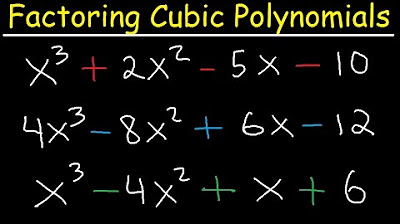Solving Polynomial Equations By Factoring and Using Synthetic Division
Summary
TLDRThis tutorial focuses on solving polynomial equations using various methods, including factoring by grouping, substitution, and the rational zero theorem with synthetic division. The instructor demonstrates how to factor polynomials, identify common factors, and solve for real and imaginary roots. Examples include solving cubic and quartic polynomials, and the tutorial emphasizes recognizing patterns such as the difference of perfect squares. By the end, viewers will understand multiple techniques for solving polynomial equations, equipping them with practical methods for tackling different types of polynomial problems.
Takeaways
- 🔢 The tutorial focuses on solving polynomial equations using various methods.
- 📐 Factoring by grouping is a technique used when the ratios of the coefficients of the first two terms match those of the last two terms.
- 🔄 Factoring involves taking out the greatest common factor (GCF) from each group of terms.
- 🔄 After factoring, if possible, further factor the expression, such as a difference of squares, to completely factor the polynomial.
- 🔍 When factoring by grouping is not possible, consider reducing the polynomial to a quadratic form using substitution.
- 🔄 Substitute x<sup>n</sup> with a variable (like 'a') to transform the polynomial into a quadratic form that can be factored.
- 🔢 For polynomials that cannot be factored by grouping or reduced to quadratic form, use the rational zero theorem to list possible rational zeros.
- 🔄 Synthetic division is used to find the remaining zeros of a polynomial after identifying one zero.
- 🔄 Imaginary numbers can be used to factor polynomials with a sum of perfect squares.
- 📝 The tutorial provides step-by-step examples for each method, demonstrating how to solve specific polynomial equations.
Q & A
What method can be used to solve the equation x³ + 3x² - 4x - 12 = 0?
-The equation can be solved by factoring by grouping because the ratio of the first two coefficients (1 and 3) is the same as the ratio of the last two coefficients (-4 and -12).
How is the equation x³ + 3x² - 4x - 12 factored?
-First, group the terms and factor out the greatest common factors. The equation is factored as (x + 3)(x² - 4). Then, factor x² - 4 as a difference of squares to get (x + 3)(x + 2)(x - 2).
What are the solutions to the equation x³ + 3x² - 4x - 12 = 0?
-The solutions are x = -3, x = -2, and x = 2.
How can you solve the equation x⁴ - 5x² - 36 = 0?
-This equation can be solved by substitution. Let a = x², then solve the resulting quadratic equation a² - 5a - 36 = 0, which factors to (a - 9)(a + 4).
What are the real and imaginary solutions to x⁴ - 5x² - 36 = 0?
-The real solutions are x = ±3, and the imaginary solutions are x = ±2i.
How do you solve x³ - 3x² - 6x + 8 = 0 using the Rational Root Theorem?
-First, list all possible rational zeros using the factors of the constant term and the leading coefficient. Then, use synthetic division to test each possible zero. After finding one root, use synthetic division to simplify the equation and find the remaining roots.
What are the solutions to the equation x³ - 3x² - 6x + 8 = 0?
-The solutions are x = 1, x = 4, and x = -2.
How do you apply synthetic division to find the remaining zeros after identifying one zero in a cubic equation?
-After identifying one zero using the Rational Root Theorem, apply synthetic division by dividing the original polynomial by (x - root). The quotient will be a quadratic equation that can be solved using factoring or other methods to find the remaining zeros.
How can you factor the polynomial x⁴ - 7x³ + 7x² + 35x - 60?
-Start by using the Rational Root Theorem to find a root. Once a root is identified, use synthetic division to simplify the polynomial and then factor the resulting expression.
What are the solutions to the polynomial equation x⁴ - 7x³ + 7x² + 35x - 60 = 0?
-The solutions are x = 3, x = 4, x = ±√5.
Outlines

Cette section est réservée aux utilisateurs payants. Améliorez votre compte pour accéder à cette section.
Améliorer maintenantMindmap

Cette section est réservée aux utilisateurs payants. Améliorez votre compte pour accéder à cette section.
Améliorer maintenantKeywords

Cette section est réservée aux utilisateurs payants. Améliorez votre compte pour accéder à cette section.
Améliorer maintenantHighlights

Cette section est réservée aux utilisateurs payants. Améliorez votre compte pour accéder à cette section.
Améliorer maintenantTranscripts

Cette section est réservée aux utilisateurs payants. Améliorez votre compte pour accéder à cette section.
Améliorer maintenantVoir Plus de Vidéos Connexes

Factoring Cubic Polynomials- Algebra 2 & Precalculus

Polinomial (Bagian 5) - Cara Menentukan Akar-akar Persamaan Polinomial

Factoring Trinomials The Easy Fast Way

Lesson 33 Long Division to Find Roots

MATH 9 - Solving Equations Transformable to Quadratic Equation Including Rational Algebraic Equation

Solving Rational Equations
5.0 / 5 (0 votes)
